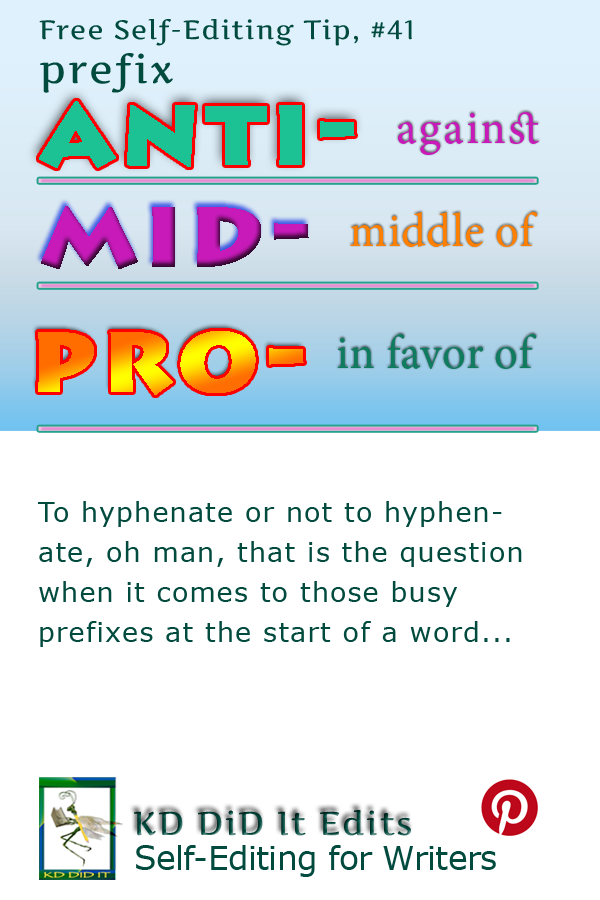A prefix is a handy little group of letters — a bound morpheme which occurs before a root, a.k.a. an unbound morpheme, that enables you to create alternative meanings from existing words. It is part of what contributes to the precision and richness of English.
The prefix generally allows its root word to retain its base meaning while fine-tuning it to be more specific.
Consider the word decorated and all sorts of possibilities it raises. Husbands think ick, work . . . painting the room, spending money on new furniture, please don’t let her do frilly, etc. Wives think paint colors, textures, roman blinds versus balloon shades.
Now consider underdecorated. Sparsely furnished. White walls. No pillows. No pictures.
The other extreme is overdecorated with frilly ruffles, lots of lace, 18,000 pillows on the bed, so much furniture you can’t move. Or maybe it’s gilt everywhere with tons of crushed velvet and Elvis paintings. Three completely different images involving decorate that depend upon the prefix used.
Grammar Explanations is . . .
. . . an evolving list of the structural rules and principles that determines where words are placed in phrases or sentences as well as how the language is spoken. Sometimes I run across an example that helps explain better or another “also known as”. Heck, there’s always a better way to explain it, so if it makes quicker and/or better sense, I would appreciate suggestions and comments from anyone on an area of grammar with which you struggle or on which you can contribute more understanding.
If you found this post on “Prefix” interesting, consider subscribing to KD Did It, if you’d like to track this post for future updates.
Return to top
| Prefix | |||||||||||||||||||||||||||||||||||||
| Definition: A letter or group of letters that is put or attached to the front of a word and not in the middle (an infix) or the end (a suffix) of a word to create a new word or intensify meaning. The opposite of a suffix.
Affix is a general term for infix, prefix, and suffix. |
|||||||||||||||||||||||||||||||||||||
| Partial List of Prefixes | |||||||||||||||||||||||||||||||||||||
|---|---|---|---|---|---|---|---|---|---|---|---|---|---|---|---|---|---|---|---|---|---|---|---|---|---|---|---|---|---|---|---|---|---|---|---|---|---|
Prefixes that feature a dotted underline are combined forms.
1 An old particle that means in the act of. Return to top or post contents |
|||||||||||||||||||||||||||||||||||||
| To Hyphenate or Not to Hyphenate | |||||||||||||||||||||||||||||||||||||
Rule: The current tendency is to eliminate the hyphen between a prefix and a root word unless:
|
|||||||||||||||||||||||||||||||||||||
| Current Practice | Don’t Double Up a Vowel | ||||||||||||||||||||||||||||||||||||
Return to top or post contents |
|
||||||||||||||||||||||||||||||||||||
| Exceptions include: | |||||||||||||||||||||||||||||||||||||
| Rule: Compound words which use a hyphen and not an en dash | Rule: You may double up the vowels on the following prefixes: | ||||||||||||||||||||||||||||||||||||
|
|
||||||||||||||||||||||||||||||||||||
| Rule: . . . with Adjectives | |||||||||||||||||||||||||||||||||||||
|
|||||||||||||||||||||||||||||||||||||
| Rule: Noun compounds are open with no prefix | |||||||||||||||||||||||||||||||||||||
|
|||||||||||||||||||||||||||||||||||||
| Rule: Certain words are expected to be hyphenated. If you question whether it should or should not be hyphenated, check the dictionary. | |||||||||||||||||||||||||||||||||||||
Return to top or post contents |
|||||||||||||||||||||||||||||||||||||
| To Capitalize or Not | |||||||||||||||||||||||||||||||||||||
| Rule: When attached to a capitalized word, prefixes are capped when part of a specific name and not capped when added to proper nouns or adjectives.
Return to top or post contents |
|||||||||||||||||||||||||||||||||||||
| Part of a Specific Name | Added to Proper Names/Adjectives | ||||||||||||||||||||||||||||||||||||
| Anti-Lebanon Mountains Neo-Christianity Neo-Hebraic Pan-American Pan-Slavic Neo-Impressionism Return to top or post contents |
ante-Norman anti-French ex-Senator post-Regency pre-Christian pro-American un-Platonic |
||||||||||||||||||||||||||||||||||||
| Use an En Dash with a Compound Word | |||||||||||||||||||||||||||||||||||||
| Rule: Use an en dash when using a prefix on a compound word | |||||||||||||||||||||||||||||||||||||
| pre–Revolutionary War post–World War II |
|||||||||||||||||||||||||||||||||||||
| Exceptions include: | |||||||||||||||||||||||||||||||||||||
Return to top or post contents |
|||||||||||||||||||||||||||||||||||||
| Confusing Homographs | |||||||||||||||||||||||||||||||||||||
| Rule: Use a hyphen between prefix and homograph IF the context isn’t enough to prevent confusion. For example, repose means rest while re-pose indicates that someone or something needs to be moved or a sentence needs to be reworded. | |||||||||||||||||||||||||||||||||||||
Return to top or post contents |
|||||||||||||||||||||||||||||||||||||
| Augmentative Prefix | |||||||||||||||||||||||||||||||||||||
| Definition: A word or affix that indicates a greater intensity or size and are the opposite of diminutives.
It can also imply awkwardness or unattractiveness. In some languages, augmentatives may be used for comical effect or as pejoratives. |
|||||||||||||||||||||||||||||||||||||
|
|||||||||||||||||||||||||||||||||||||
C’mon, get it out of your system, bitch, whine, moan . . . which words are your pet peeves? Also, please note that I try to be as accurate as I can, but mistakes happen or I miss something. Email me if you find errors, so I can fix them . . . and we’ll all benefit!
Satisfy your curiosity about other Grammar Explanations by exploring its homepage or more generally explore the index of self-editing posts. You may also want to explore Book Layout & Formatting Ideas, Formatting Tips, Grammar Explanations, Linguistics, Publishing Tips, the Properly Punctuated, Word Confusions, Writing Ideas and Resources, and Working Your Website.
Resources for Prefix
Some of these links may be affiliate links, and I will earn a small percentage, if you should buy it. It does not affect the price you pay.
Chicago Manual of Style. p 7.9.
“English Language Roots Chart.” Prefix-Suffix. n.d. Web. n.d. <http://www.prefixsuffix.com/rootchart.php>. A handy chart that lists and explains the more common prefixes to base words and is a small part of their 2,000 word root database which is searchable using their root search engine.
Skillin, Marjorie E., Robert M. Gay, and other authorities. Words into Type. Third edition. New Jersey: Prentice-Hall, Inc: 1974. <https://amzn.to/3YCK74z&g; Print. 168, 223-224.
Pinterest Photo Credits:
Kathy Davie’s own creation.
Revised as of 18 Oct 2024
By: Kathy Davie

